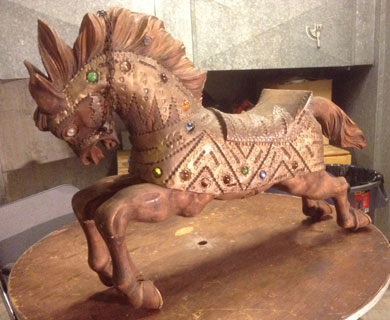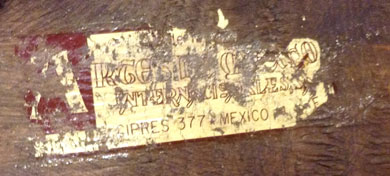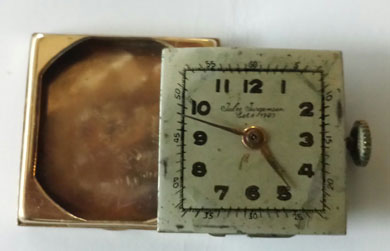 |
|
|||
 |
 |
|||
Copyright © Harry Rinker, LLC 2014 Questions
and Answers
QUESTION: My wife and I have owned a carousel-type horse for the past 20 years. The wooden horse has a carved body with flaring mane and tail, geometric designs on the side of the body, brass or copper trim, and marble accents. A label under the horse suggests it is from Mexico. The horse was a gift from friends who loved to travel. Would you have any idea of value? – AJ, Janesville, WI, Email Question
ANSWER: The horse you own was designed for decorative/ conversation purposes. Although you did not provide a size, it appears to be between four and five feet long. Since there is no hole in the saddle area, it most likely is not carousel related. Even outside standers on a carousel had a pole through the body for the child to grasp. I was unable to decipher the label on the bottom. However, it is clear that the horse was made in Mexico. Based on its appearance and aging, my best guess is sometime in the 1970s or 1980s. The carving and decorative techniques suggest a quick “knock-it-out” construction. I remember seeing large numbers of such carousel-like horses for sale at flea markets during that time.
An unscrupulous dealer will try passing your horse off as an example of Mexican folk art. In reality, it is an example of Mexican schlock. Modern examples sell in the $250.00 to $400.00 range. Some dealers ask more. This is a case where the “heart” dictates to the mind what a person is willing to pay. As always, my advice is to think conservatively -- $150.00 to $175.00. If you can find someone willing to pay more, kiss the hand and take the money. QUESTION: I am desperately trying to get a true piece of history authenticated. My grandfather’s scrapbook contains five picture postcards and two pieces of the fabric from the airship “Akron.” My grandfather lived in Atlantic City in 1912. The “Akron” was the first airship built by Goodyear. When leaving the Abescon Inlet at Atlantic City, the airship exploded on July 2, 1912 killing Melvin Vaniman, who was the pilot for the ship, and its three-man crew. Pieces of the airship fabric were cut up and sold as a means of raising funds for the widows. One piece of fabric, measuring 5 inches by 1 1/4 inches, is from the fundraiser. A tag states it is from the “Akron” and has the date of the accident, date of the fundraiser, and the number “1112.” The second piece is larger, 6 inches by 1 1/2 inches. “Vaniman’s wreck, all four killed on July 2, 1912” is written on the fabric. When I tried to sell the fabric to several Atlantic City dealers, they asked if I had a certificate of authenticity. I do to not. I have tried everything – contacting the Goodyear Corporation, the National Archives, the Smithsonian, airship groups, and even Pawn Stars. How do I obtain a certificate of authenticity so that I can sell my two pieces of fabric from the “Akron”? – CT, Pottsville, PA, E-mail Question ANSWER: Do not confuse the 1912 explosion of Vaniman’s “Akron” which used a highly volatile hydrogen gas with the April 4, 1933, explosion of the “USS Akron” (ZRS-4), a helium-filled rigid airship. American airship/dirigible collectors tend to focus more on the second rather than the first. Chester Melvin Vaniman (1866-1912) was an adventurer and photographer. As a photographer, he specialized in panoramic images taken from great heights. Photographing from gas balloons was a favorite technique. Vaniman became fascinated with airships, attempting trips to both the North Pole and a Trans-Atlantic crossing in the airship “America” before his adventure aboard the “Akron.” Although there had been earlier airships in America, the “Akron” was the only airship in the United States in 1912. Paul Litchfield, a Goodyear engineer, brought a machine from Scotland that applied rubber to fabric. The gas cells for the “Akron” were made in Akron. The ship was assembled in Atlantic City in November 1911. Winter weather forced the postponement of what was to be a Trans-Atlantic flight until the summer. [See: http://www.akronhistory.org/blog/uncategorized/the-1912-dirigible-akron/; http://www.naval-airships.org/resources/Documents/VINTAGE.RADIO.0111.pdf; http://en.wikipedia.org/wiki/Melvin_Vaniman] Put aside any thoughts of getting a certificate of authenticity. Such certificates are viewed with distrust and distain by those in the antiques and collectibles trade. Rather, work on establishing a stronger provenance for the two fabric pieces. First, obtain newspaper and other accounts of the disaster. One source indicated that “the gas bag was not examined due to souvenir hunters having taken pieces.” [Author’s Note: The gas bag was enclosed in an air bag. The airbag was sent to Goodyear for examination.] Your second piece of fabric most likely resulted from this first round of souvenir hunting. I could not find any documentation on the internet for the auction of pieces of the gas bag to raise money for the widows. The story is plausible. Obtain proof that the auction took place. The date of the auction is on the tag. Find one or more newspaper articles describing the auction. Second, establish that your grandfather lived in Atlantic City in July 1912. Look for any records that might be available. City directories are a good place to start. Ideally, other material in the scrapbook will confirm the date. In terms of selling the pieces to dirigible collectors, finding them will be a challenge. The American dirigible/airship collectors’ clubs of the past are gone. Most of the major American collections were sold, either because the collector died or reached a point where he no longer cared. The Navy Lakehurst Historical Society, which focuses on preserving the Lakehurst airship station and the naval dirigibles stationed there, is the only American museum with an airship focus. The good news is that there are more than half a dozen airship museums in Europe. Photographic images of the “Akron,” Vaniman, and the crew are available. My suggestion is to obtain a black and white copy of one or more images of the “Akron” over Atlantic City. Have it/them matted along with a piece of the fabric and placed in a nice frame. This is known as enhancing the presentation value of an artifact. Once the framing is complete, contact auction houses that specialize in the sale of historic material, such as Heritage Auctions in Dallas, to determine what interest the auctions houses may have in selling the two framed pieces. If I am correct, the buyers will be from England or Europe. The value of each piece of fabric is between $200.00 and $250.00. Matted and framed as suggested, the value should jump to $750.00 to $1,000.00. These values are based on your ability to assemble the documentation I suggested. QUESTION: I have a copy of the first printing of Ward Greene’s “Lady and the Tramp” published by Simon and Schuster in 1953. The cover is plain. There is no dust jacket. What is my book worth? – L, Reading, PA ANSWER: Ward Greene’s short story “Happy Dan, the Whistling Dog appeared in “Cosmopolitan in the early 1940s. When Walt Disney was looking for a story for his 15th animated cartoon, he turned to Greene’s story for inspiration. Although the movie “Lady and the Tramp” was not released until June 1955, Disney backed the publication of the hardcover book “Lady and the Tramp, the story of two dogs” in 1953. Ward Greene was listed as the author. The book had a dust jacket that pictured Lady and the Tramp in an oval. The background color was a pale blue. Without a dust jacket but otherwise in good condition, booksellers on www.abebooks.com are asking between $175.00 and $200.00. I did find listings on other internet sites below $100.00. A copy of “Lady and the Tramp” with a dust jacket in very good or better condition starts at $450.00 and goes up from there. Signed copies by Disney or specially bound copies command premium prices. The publication of this book two years before the release of the animated cartoon demonstrates Disney’s market sophistication. Disney mastered the art of pre-release product hype to stimulate interest in future products, a process that reached its peak of perfection in the promotion leading up to “101 Dalmatians.” QUESTION: I have a Jules Jurgensen watch that my grandmother gave to me 30 years ago. I believe it is from the 1960s. The mesh band, clasp, and backing is 14K. Because the mesh band was too big, a portion was removed and turned into a necklace. I would appreciate your thoughts regarding value. – BJ, Atlanta, Email Question
ANSWER: I looked at hundreds of images of Jules Jurgensen men’s wristwatches. I did not find any whose face matched the watch that you have. Your face seems “crude” in workmanship and design to the watch images I found. Take the watch to a local jeweler and seek his/her opinion. You did not indicate in your email whether the watch worked or not. I am assuming it does not. Even if it does, the quality is such that a buyer only will be interested in the melt value of the band and case, assuming it is 14K. Again, ask a local jeweler to test the band. The precious metals market has decreased sharply. Currently (mid-February 2015) the spot market for gold is around $1,320.00 per ounce, down from over $2,000.00 per ounce several years ago. 14K gold is about $720.31 per ounce. I am keeping my fingers crossed your band and case is 14K and not 14K gold plated.
Harry L. Rinker welcomes questions from readers about
collectibles, those mass-produced items from the twentieth and twenty-first centuries.
Selected letters will be answered in this column.
Harry cannot provide personal answers.
Photos and other material submitted cannot be
returned.
Send your questions to: Rinker on Collectibles, 5955 Mill
Point Court SE, Kentwood, MI 49512.
You also can e-mail your questions to
harrylrinker@aol.com.
Only e-mails containing a full name and mailing address
will be considered.
You can listen
and participate in
WHATCHA GOT?, Harry’s
antiques and collectibles radio call-in show, on Sunday mornings between 8:00 AM
and 10:00 AM Eastern Time.
If you
cannot find it on a station in your area,
WHATCHA GOT?
streams live on the Internet at www.gcnlive.com.
SELL, KEEP OR TOSS?: HOW TO DOWNSIZE A HOME,
SETTLE AN ESTATE, AND APPRAISE PERSONAL PROPERTY
(House of Collectibles, an imprint of Random House Information Group, $17.99),
Harry’s latest book, is available at your favorite bookstore and via
www.harryrinker.com.
|
||||



